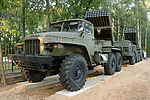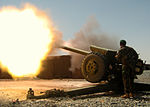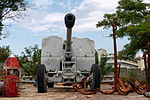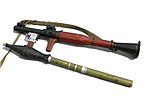The Abkhazian Armed Forces (Abkhaz: Абџьарирқәу Амҷқәа Аԥсны; Russian: Вооружённые силы Абхазии) are the military forces of Abkhazia.[notes 1] The forces were officially created on 12 October 1992, after the outbreak of the 1992–1993 war with Georgia.[2] The basis of the armed forces was formed by the ethnic Abkhaz National Guard. The Abkhaz military is primarily a ground force but includes small sea and air units. According to the authorities of the Republic of Abkhazia, the Abkhazian Land Forces are organised along the Swiss model – in time of peace they have personnel of 3,000 to 5,000 and in case of war further 40–50,000[3] reservists are called out. Georgia regards the Abkhaz armed forces as "unlawful military formations" and accuses Russia of supplying and training the Abkhaz troops.
| Abkhazian Armed Forces | |
|---|---|
| Абџьарирқәу Амҷқәа Аԥсны Аҳәынҭқарра Вооружённые силы Республики Абхазия | |
 Banner | |
| Motto | For Our Fatherland Хапсадгып Азы За Наше Отечество |
| Founded | 12 October 1992[1] |
| Service branches | |
| Leadership | |
| Commander-in-chief | |
| Prime Minister | Alexander Ankvab |
| Minister of Defence | Colonel General Vladimir Anua |
| Chief of Staff | Vasily Lunev |
| Personnel | |
| Active personnel | 2,500–3,000 |
| Reserve personnel | 5,000–10,000 |
| Industry | |
| Foreign suppliers | |
| Related articles | |
| History | Military history of Abkhazia Abkhazian War Six-Day War of Abkhazia Kodori Crisis Russo-Georgian War |
| Ranks | Military ranks of Abkhazia |
History
The Ministry of Defence and the General Staff of the Abkhazian armed forces were officially created on 12 October 1992, after the outbreak of the 1992–1993 war with Georgia.[2] The basis of the armed forces was formed by the ethnic Abkhaz National Guard created earlier in 1992 prior to the outbreak of the war. It also takes its roots from the Separate Regiment of Internal Troops, which was disbanded in 1991.[4] During the war, the Abkhazian forces – with the critical support from the Confederation of Mountain Peoples of the Caucasus, Cossack volunteers and Russian regular military units[5][6] stationed in or near Abkhazia – succeeded in defeating the Georgian troops; Georgians, Armenians, Greeks, Russians and Abkhaz were killed.[7] Roughly 200,000 to 250,000 Georgian civilians became Internally displaced persons (IDPs).[8][9][10][11] Most of the military's weapons come from the Russian airborne division base in Gudauta,[12][13] while others were captured from Georgian forces.
Georgia regards the Abkhaz armed forces as "unlawful military formations" and accuses Russia of supplying and training the Abkhaz troops, partly in exchange for Abkhaz land or hotels. The Abkhaz deny this, saying they bought what they have on the free market except for five sea cutters received from Russia and speedboats from the Abkhaz diaspora in Greece.[14] In March 2005, then Abkhazian defence minister Sultan Sosnaliev said that the senior and middle-ranking officers in the Abkhaz army are regularly sent to Russia for 2–3 month training courses within the framework of the Russia's "Vystrel" (Shot) program.[15]
Sosnaliev himself is a Russian officer from the Kabardino-Balkaria Republic (Russian Federation) and held the same post during the Abkhazian war, when Chechen field commander and militant Shamil Basayev was his deputy. Similarly, former chief of staff, Major General Anatoly Zaitsev had previously served as deputy commander of the Transbaikal Military District (now part of the Siberian Military District) in Russia. Another top official, Deputy Defence Minister Aleksandr Pavlushko is a Russian colonel and the former chief of staff of the Russian peacekeeping forces in Abkhazia.[16] Georgia also regularly accuses Abkhazia of forcibly recruiting Georgian returnees from the Gali district into the armed forces.[14]
The Abkhaz military is primarily a ground force but includes small sea and air units. In 2006, an "anti-terrorist centre" of some 200 personnel was created under the de facto ministry of interior. The de facto minister of finance estimated, in 2006, that 35 per cent of Abkhazia's budget was spent on the military and police.[14]
On 8 May 2007, Minister of Defence and Vice Premier Sultan Sosnaliyev resigned.[17] He was succeeded as Defence Minister (but not as Vice Premier) by First Deputy Defence Minister Mirab Kishmaria, in an acting fashion from 10 May and permanently from 26 July onwards.[18]
On 14 April 2010, five Deputy Ministers of Defence were retired, including Chief of the Armed Forces Anatoli Zaitsev.[19] Aslan Ankvab was appointed acting First Deputy Minister of Defence and Chief of Staff. On 21 May 2010, Beslan Tsvishba was also appointed First Deputy Minister of Defence.[20] On 29 March 2011, Vladimir Vasilchenko succeeded Aslan Ankvab to become the new, permanent, Chief of Staff and First Deputy Minister of Defence.[21]
On 24 November 2014, the governments of Abkhazia and Russia signed a treaty of cooperation that creates a joint force of troops from the two countries.[22] In September 2019, Russian President Vladimir Putin approved a proposal to finance the modernization of the Abkhazian Armed Forces.[23]
On 18 May 2015, retired Russian army general Anatoly Khrulyov was appointed Chief of the General Staff by President Raul Khajimba.[24]

Organisation
Military leadership
| From | # | President | # | Minister of Defence | # | Chief of the General Staff |
| 1992 | No president | 1 | Vladimir Arshba | 1 | Sultan Sosnaliyev | |
| 1993 | ||||||
| 2 | Sultan Sosnaliyev | 2 | Sergei Dbar | |||
| 1994 | ||||||
| 1 | Vladislav Ardzinba | |||||
| 1995 | ||||||
| 1996 | ||||||
| 3 | Vladimir Mikanba | 3 | Vladimir Arshba | |||
| 1997 | ||||||
| 1998 | ||||||
| 1999 | ||||||
| 2000 | ||||||
| 2001 | ||||||
| 2002 | ||||||
| 4 | Raul Khajimba | |||||
| 2003 | ||||||
| 5 | Viacheslav Eshba | |||||
| 2004 | ||||||
| 2005 | ||||||
| 2 | Sergei Bagapsh | 6 | Sultan Sosnaliyev | 4 | Anatoli Zaitsev | |
| 2006 | ||||||
| 2007 | ||||||
| 7 | Mirab Kishmaria | |||||
| 2008 | ||||||
| 2009 | ||||||
| 2010 | ||||||
| Aslan Ankvab | ||||||
| 2011 | ||||||
| 3 | Alexander Ankvab | 5 | Vladimir Vasilchenko | |||
| 2012 | ||||||
| 2013 | ||||||
| 2014 | ||||||
| Valeri Bganba | ||||||
| 4 | Raul Khajimba | |||||
| 2015 | ||||||
| 6 | Anatoly Khrulyov | |||||
Structure

It is also divided into the following Military Districts:
- Central Military District (Sukhumi)
- Eastern Military District (Ochamchire)
- Western Military District (Pitsunda)
Branches
Army
According to the authorities of the Republic of Abkhazia, the Abkhazian Land Forces are organised along the Swiss model – in time of peace they have personnel of 3,000 to 5,000 and in case of war further 40-50,000[3] reservists are called out. They are authorised to keep registered weapons at home.
It is divided into the following formations:
- General Staff Headquarters
- 1st Motor Rifle Brigade
- 3-4 Motorized rifle battalions
- Tank battalion
- 2nd Motor Rifle Brigade
- 3-4 Motorized rifle battalions
- Tank battalion
- 3rd Motor Rifle Brigade
- 3-4 Motorized rifle battalions
- Tank battalion
- Artillery Regiment
- Engineering Battalion
- Mountain Infantry Battalion
- Intelligence Battalion
- Independent Special Purpose Detachment
The Abkhazian Navy consists of three divisions that are based in Sukhumi, Ochamchire and Pitsunda. Four ships Project 1204 Shmel class PBR, 657 (ex-AK-599), 658 (ex-AK-582), and 328 (ex-AK-248) were transferred from the Russian Navy in the late 1990s.[citation needed] An additional ship ex-AK-527 was also transferred and cannibalized for spares.[citation needed] The three Abkhaz ships did not take part in the 2008 South Ossetia conflict, but their state was unclear. As of 2005 the first two of them had one PSKA Project 1400M Grif ("Zhuk") class PC speed-boats each. The navy also includes several civil vessels that were equipped with guns and unguided rocket artillery systems.NOVOSTI (Russian News & Information Agency) gives the following naval figures: over 20 motor boats armed with machine-guns and small-caliber cannons.
Air Force
The Abkhazian Air Force uses Russian and Soviet-built aircraft. It is a small force, which numbers only 7 aircraft, 3-4 helicopters, and 250 personnel.
Education
- Sukhumi Higher Combined-Arms Command School
- The Combined-Arms Academy of the Ministry of Defense at Abkhaz State University. The main mission of the Combined Arms Academy is to train officers with higher military education. The Combined-Arms Academy was the first military educational institution to which the training of officer personnel in operational-tactical command was given entrusted.[25]
Equipment
The exact numbers and types of equipment remain unverifiable as no thorough international monitoring has ever been carried out in Abkhazia. NOVOSTI (Russian News & Information Agency) gives the following army figures: 10,000-strong Abkhazian Self Defense Force wielding 59 tanks, including 9 T-72s, 92 artillery pieces and mortars, including several dozen with a 122–152-mm caliber and 36 armored vehicles of different types, also has numerous anti-tank weapons ranging from RPG-7 rocket launchers to Konkurs-M anti-tank guided missiles (ATGMs).[26] Given the status of Abkhazia and recent armed conflict with Georgia a variety of equipment has been utilized by formations of the Abkhazian military, including inherited Soviet equipment, donated Russian weapons, impressed civilian gear, and items captured from the Georgians.
Armored combat vehicles
| Model | Image | Origin | Type | Number | Notes | |
|---|---|---|---|---|---|---|
| Tanks | ||||||
| T-72 |  |  Soviet Union Soviet Union Russia Russia | Main battle tank | 9 | ||
| T-55 |  |  Soviet Union Soviet Union | Main battle tank | 35 | 15 lost in the Abkhazia War Many not able to operate | |
| Infantry fighting vehicles | ||||||
| BMP-2 |  |  Soviet Union Soviet Union Russia Russia | Infantry fighting vehicle | 25 | ||
| Armored cars | ||||||
| BRDM-2 |  |  Soviet Union Soviet Union | Amphibious armoured scout car | 11 | ||
| Anti Air vehicles | ||||||
| 9K37 Buk |  |  Soviet Union Soviet Union Russia Russia | Surface-to-air missile system | |||
| ZSU-23-4 Shilka |  |  Soviet Union Soviet Union Russia Russia | Self-propelled anti-aircraft weapon | 5 | ||
Artillery
| Model | Image | Origin | Type | Number | Notes |
|---|---|---|---|---|---|
| Artillery | |||||
| BM-21 "Grad" |  |  Soviet Union Soviet Union | Multiple rocket launcher | 14 | |
| 122 mm 2A18 |  |  Soviet Union Soviet Union | Field artillery | About 90 towed field artillery pieces are in service (2019).[citation needed] | |
| 85 mm D-44 |  |  Soviet Union Soviet Union | Field artillery | ||
| 120 mm mortar |  |  Soviet Union Soviet Union | Mortar | About 42 mortars are in service; exact types are unspecified.[citation needed] | |
| 82 mm mortar |  Soviet Union Soviet Union | Mortar | |||
| KSM-65 100 mm |  |  Soviet Union Soviet Union | Coastal artillery | In 2008 some were reactivated from storage; exact types and number are unspecified.[27] | |
Small arms
Russian troops
Russia maintains a 3,500-strong force in Abkhazia with its headquarters in Gudauta, a former Soviet military base on the Black Sea coast north of the capital, Sukhumi, under a September 2009 agreement on military cooperation.The Gudauta base hosts Russia's 131st Separate Motorized Rifle Brigade, equipped with at least 41 T-90 main battle tanks and 130 BTR-80 APCs.[citation needed] The brigade is said to the subordinate to the Russian 49th Army headquartered in Stavropol. As of 2021, the Bombora air base (7th Military Base) also hosts air defence assets which reportedly include S-400 and S-300 surface-to-air missile units.[28]
Symbols
- The Day of the Armed Forces is celebrated on 11 October.[29]
- The cities of Tkvarcheli and Gudauta are considered to be "hero cities" as they were awarded the title of Hero of Abkhazia as a result of their military glory.[30][31][32]
- On 12 July 2018, the Law "On the Banner of Victory in the Patriotic War of the People of Abkhazia 1992–1993" was adopted by deputies of the Parliament, being symbol of the military victory of the Abkhazian Armed Forces.[33] Not to be confused with the Soviet Victory Banner, which was raised by the Red Army soldiers on the Reichstag building on 1 May 1945, the Abkhazian Victory Banner was hoisted on the state border along the Ingur River on 20 September 1993. It is currently maintained by the Ministry of Defense of Abkhazia. The location, order and use of the banner is determined by the President of the nation.[citation needed]
- The Bank of Abkhazia, which responsible for the Abkhazian apsar has issued two coins honoring the Abkhaz military in the patriotic war.
Notes
References
Bibliography
- Давид Петросян (David Petrosyan). Проблемы непризнанных государств на постсоветском пространстве: Южный Кавказ (Problems of the unrecognised states in the former USSR: South Caucasus) (in Russian)
- Милитаризм по-кавказски (Caucasian-style militarism), Независимая Газета (Nezavisimaya Gazeta), 13.10.2001 (in Russian)
- Абхазский де-факто министр рассказывает о приоритетах, "Civil.Ge", Tbilisi 2005-01-04 (in Russian)
- Багапш приказал топить грузинские суда, Независимая Газета, 25.07.2005 (in Russian)












